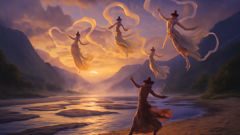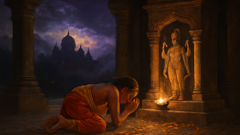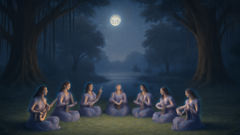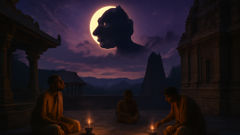Introduction
Along the indigo curve where monsoon clouds gather and rivers swell, the world quietly remembers the apsaras. They are not simply creatures of legend but breathings of the sky and the water: luminous women who move as if the wind had given them voice and the river had taught them timing. In temples and on temple friezes, they are caught mid-gesture—fingers poised like petals, feet balancing on a breath—yet to reduce them to stone is to miss their true domain. Apsaras belong to the mobile things: the arc of rain, the reflection on a flooded field, the hush that falls after a bell. They are at once teachers of classical dance and muses of improvisation, custodians of uncounted seasons.
This story opens where the land is soft with rains and the night is seeded with frogs. It draws on the old names—Menaka, Urvashi, Rambha—but it also imagines new movements and new faces: an ordinary river dancer named Tara whose path crosses the invisible currents that the apsaras inhabit. Through origin whispers and intimate encounters, this tale traces how movement becomes meaning, how music can change weather, and how the line between human longing and divine play thins beneath the same low clouds. You will find stories here of courtly kings who bargained for beauty, ascetics who sought distraction, and the rivers that carried vows into the sea, all braided together by the apsaras' dance. Let the rhythm of the words, like a measured tala, guide the steps.
Origins of the Sky-Dancers: Myth, Motion, and the Making of Water
To speak of apsaras is to speak of liminality—the edge where heaven and earth converse. In the oldest tellings, they are born from the churning of the ocean, the Samudra Manthan, appearing like sudden bloom on the crest of foam. They are gifts, rewards, and sometimes distractions, offered to the gods and to men alike. But mythic origins only paint the broad strokes; the true contours of the apsaras are found in motion. They are movement incarnate: the way rain hangs for a beat on a leaf before sliding off; the way a fish flicks and sends ripples that catch the light. They are choreography woven into the weather.
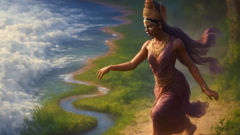
Their bodies are always described in relation to sound. Apsaras learn to dance in the cradle of tala, to match their breath with conch calls and drumbeats. They owe their names and reputations to specific measures: a slow, patient laya for the earth-slow rains, an alacrity for summer storms. Menaka, cast from the celestial foam, becomes shorthand for seductive grace; Urvashi, whose laughter echoes canyon-to-canyon, becomes the archetype of celestial longing. Yet these names do not chain them; each apsara contains a hundred variations, improvisations that reveal her particular affinity with a river, cloud, or grove.
In the temples artisans carved them into stone as if to insist that the ephemeral might be given permanence. On the pediments of ancient sanctuaries, apsaras freeze with tilted heads and flaring eyes, anklets that look poised to jingle even centuries later. But stone can only hint at their essence. The apsara is the space between the anklet's ring and the silence that follows—the breath that anticipates a gesture. To witness an apsara is to feel a pattern of time itself loosen: hours compress into a single phrase of movement and then bloom outward. With each step she sows weather in a new direction; dancers on earth sense the pattern and replicate it in festivals, offering their own bodies as channels for cloud and rain.
Apsaras also operate as moral fulcrums in myth. Kings who are unmoored by desire find themselves entangled in the apsaras' play; sages who cultivate extreme asceticism are sometimes redirected by a dance that tests the limits of their resolve. This is not mere seduction for vanity's sake; it is the world calibrating itself. Where austerity pushes the cosmos into imbalance, the apsaras arrive to remind it of joy, of the necessity of art and attachment in the cathedral of living things. In such stories the apsaras become agents of return: they restore equilibrium by opening hearts, softening hardened gazes, and coaxing water back into the cracked soil.
Their relationship to rivers is intimate and ancestral. In one persistent motif, an apsara descends to the river to lift its skin—smoothing currents, rearranging stones, teaching the water to sing particular refrains so that fishermen and reed-cutters will recognize the tides. Rivers answer in their own register. A river that remembers an apsara's cadence will change course subtly, forming a bend that holds a village's field and brings fertility. Many local folktales give credit to an apsara for a sudden spring or a well that never runs dry. The apsaras are, in effect, rural hydrologists of a poetic sort: caretakers of flow, memory, and the human practices that depend on steady water.
The apsaras’ dominion extends beyond blessing: they also bear the weight of consequence. When an apsara’s dance is interrupted—by a king who seizes her presence for trophy, by a tree-feller who does not listen—storms can turn harsh, seasons may falter, and communities learn, sometimes painfully, that the web of reciprocity has been breached. Such tales are common in oral traditions across the subcontinent: a harvest fails until a ritual dancer performs an ancient tala to coax rain, or a fisherwoman remembers a lullaby an apsara taught her grandmother and the fish return. These stories do not separate the human from the divine; they make visible the ongoing conversation between craft, devotion, and ecology.
Beyond ecology and ritual, apsaras teach technique. Classical dance forms—Bharatanatyam, Odissi, Kathak, Kuchipudi—carry, within their codified mudras and footwork, faint echoes of the apsaras’ improvisations. Scholars and older maestros will tell you that when the repertoire is at its most alive, the dancer is channeling an apsara’s impulse: microtiming, breath-managed pauses, the flicker of eyebrows that implies the weather to follow. While temples preserve iconography, living practice preserves the apsaras' secret vocabulary: the way a wrist curves not just for beauty but to trace a rain's descent; the way a torso yields at a certain angle to mimic a river's yielding around a rock. These are technical inheritances that link the earthbound dancer to the sky-dweller.
In many ancient chronicles, apsaras are also storytellers woven into courtly life. Kings commissioned them not only for spectacles but for subtle instruction. Apsaras could perform scenes of valor, folly, and reconciliation—lessons wrapped in delight. This is one reason why the apsaras remain ambivalent figures: participants in heavenly play and instruments of human consequence. They are couriers of wonder and of warning, reminding mortals that beauty, unmoored from wisdom, becomes a perilous charm.
To understand the apsaras is to accept a porous world, one in which metaphors have bodies and bodies can change the weather. Their movements translate into the environment; their laughter can loosen cloud-banks; their sorrow can hush a river. They invite human beings into an ethic of attention: to listen for the rhythm under the daily noises, to honor water as memory, and to treat art as a possible mediator between desire and restraint. The remainder of this tale follows one such mediation: a human dancer named Tara whose apprenticeship with an apsara reveals how a single dance can alter not only a life but the course of a river valley.
Tara and the Apsara: An Apprenticeship Between Riverbank and Cloud
Tara was not born to grandeur. She grew up in a village that sat like a comma where the river widened into a marsh—a place where the world pressed its ear to the water and listened for weather. Her family were reed weavers and occasional temple drummers; their life was built on measures—when to sow, when to mend, how to count the rains. Tara's first dance came on an evening of ordinary chores, when she mimicked the fisherfolk's motions as they hauled in nets. Her toes dug into the soft bed of mud, and that small ritual shaped her posture: knees slightly bent, eyes always searching the horizon.
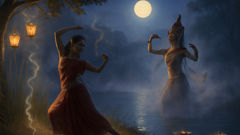
Word of Tara’s unusual timing spread. She could sense a change in the river’s song before the elders could, and her movements came as answers. A drought year found her teaching other children a simple foot pattern that mimicked the rain's arrival, a movement that had once been a lullaby. In the mornings, she practiced on the steps of a small shrine where an old bell hung, and the bell's marrowed tone braided with her breath. Though her tutors were local and humble, there was about Tara an openness that the village elders, in their quieter moments, sometimes whispered could be called an apsara’s touch.
That year, as clouds stitched themselves thin and scattered, the village faced the brittle threat of failure. Crops curled where they shouldn't have; the well sputtered. They performed the customary rites—offerings, chants, and the circling of lamps—but the season's heart remained stubborn. One twilight, when the river looked like a long black ribbon and the sky kept its rain as if hoarding treasure, Tara felt a pull toward the deeper bend, toward a hollow where papyrus clustered and the air tasted of old secrets. She moved as she always did, lips shaping an ancient cadence her grandmother had hummed, and stepped into the hollow.
At first she thought it a trick of light. A shimmer rose from the water: more motion than mist, more attention than fog. Then a figure came into being—an apsara, not a grand courtly apparition but something immediate and intimate. Her name was not given; she introduced herself through a sequence of gestures, as if language were a dance. The apsara's hair had the luster of a night after rain; her anklet sounded like distant pebbles. She did not speak of kings or curses. Instead she offered Tara a single proposition: to learn.
Learning from an apsara, Tara discovered, was not about mimicry. It was an apprenticeship of listening. The apsara taught her to fold time, to hold a pause so that it could seed thunder; she showed Tara how a single finger's infinitesimal turn could entice a breeze into shape. The lessons were both pragmatic and perilous: they demanded discipline, humility, and an ethical thread. The apsara made one rule plain—dance must be given, never taken. When performed freely, dance returns; when stolen for selfish ends, it withers and darkens weather and heart alike.
Tara's training was punctuated by weather. On days of instruction, the river would learn new phrases and respond with small miracles: the mud on the far bank soaked and released a sheen of fish the next morning; a thirsty patch of field found a stream running shoulder-deep. Villagers began to speak of Tara in tones that hovered between awe and fear. Some believed that the apsara's touch would make Tara a conduit of bounty; others whispered of consequences—that any human flirting with the divine would invite tests of loyalty.
Those tests arrived as they always do in story: through desire and through the vanity of those who would possess beauty. A neighboring chieftain, hearing rumors that the village contained a dancer who could call forth rain, came with silver cloaks and questions. He watched Tara perform on a raised platform beneath strings of lanterns, and in his eyes the dance became a map to his own wants. He offered her titles and land, expecting that possession could convert art into treasure. Tara felt the ache of temptation. The apsara's rule—dance must be given—hung like a distant bell in her mind. If she accepted the chieftain's offer, would her art become a commodity that redirected the river's favor? Would the village lose the quiet, mutual economy it had always had with water and weather?
Worse still, not all tests were external. Tara learned that the apsara herself carried histories of heartbreak. Spirits, even celestial ones, could be tired of being used as instruments of change for the selfish. The apsara told Tara, without bitterness but with the gravity of someone who had watched empires assume themselves divine, a story of a time when kings demanded rains and built monuments with the spoils. The apsara had danced to please, and the result had been splintered joy and a land that forgot its old rituals. That memory shadowed Tara's training and made every measured step an ethical negotiation.
When the chieftain demanded a private performance—an unbound offering of the river’s favor—Tara refused. Rumors ferment quickly in villages where water is life, and the chieftain’s rejection was not kind. He withdrew his promise but left behind a saber of influence: emissaries who took an interest in the shrine and in which rituals counted. Their presence was like a new undertow, and the village felt uncertain. The apsara did not vanish but grew stiller in her teachings. She taught Tara the next lesson in a series of whispered movements: how to dance so that the river could remember its own source, how to weave gratitude into motion. It was an instruction in refusal as much as in elegance.
Tara's performance at the harvest festival that followed was unlike any before. She danced not for prize or patron but in deliberate reciprocity. The choreography carried the memory of blossoms, the weight of seed, and the sound of her people's laughter. With each footfall she placed offerings—tiny piles of reed and salt—into the river’s edge, gifts that mapped the boundaries of mutual dependence. The apsara hovered just beyond sight, her presence like a punctuation in the air, and through Tara's body the village understood anew that dance could restore more than weather: it could restore a moral calculus.
When the monsoon finally arrived, it did not do so like an act of submission but as a conversation. Rain came in measured phrases, not torrential erasure; it filled reservoirs, eased droughted wells, and left fields ready for seed. The chieftain's anger cooled in proportion to the land's relief. He began to watch not with entitlement but with a curiosity nudged toward respect. Tara's refusal had been stern enough to preserve the apsara's gift for the community while allowing the chieftain to learn a new humility.
Years later, Tara taught other children. She kept one set of lessons private—those given by the apsara—to be shared only with those who intended to live within the shared economy of river and village. She never again sought title, though villagers sometimes offered her ways to be set above the rest. She would accept only the river's gifts: a place to practice, a small stipend of rice, and, most importantly, the freedom to dance for the land. The apsara's presence in the valley eased to occasional visits: seasons when the river would sing a new tune and a child would learn a foot pattern that had once belonged to the sky.
The story of Tara and the apsara became part of the valley's oral ledger: a narrative woven into wedding songs, recited by elders as a gentle reprimand against greed. It taught that art is a public good when it is nurtured by reciprocity and that nature listens for the cadence of human humility. Above all, it preserved the apsaras’ most difficult wisdom: that the most potent dances are those that teach people to see themselves as nodes in a wider luminous network, not masters of it.
Even now, on the salt-heavy nights when the moon slides low, villagers swear the apsara still appears in certain ripples, forming the suggestion of a footfall across the water. Children try to copy the rhythm; some succeed enough to find a fish in their net or a patch of soil that surprises with new green. The apsara keeps her distance from spectacle, preferring the economy of small miracles. And the valley, having remembered its lesson, keeps its own rule: to give first, to sing next, to take only what the river and the sky offer.
In the quiet that follows, the apsaras' larger presence persists across India’s mosaic: in festival pavilions and in whispered village songs; in the precision of a Bharatanatyam dancer’s wrist and the looseness of a monsoon improvisation. Theirs is a legacy that resists simple ownership. They are at once the meta-storytellers of the weather and the invisible choreographers who ask the human world to remember its place within a living system. Through Tara’s apprenticeship we see how dance mediates desire and restraint, and how the same movements that coax rain can also cradle community.
Conclusion
Apsaras resist final definition because they occupy transitions: between sky and water, between craft and play, between human urgency and the patience of nature. Their story is not only a gallery of seductive vignettes but an ongoing instruction in how to live with attention. By tracing their mythic origins and following Tara’s humble apprenticeship, this tale argues that aesthetics and ecology are inseparable in worlds where weather listens. Dance, in the apsaras’ arithmetic, is a form of stewardship; it is how communities learn to speak to rain and how rivers learn to remember those who tend them. Remembering the apsaras, then, becomes a cultural act of reciprocity: a promise to tune measures of desire to the long timescale of seasons, to hold beauty accountable to wisdom, and to acknowledge that sometimes the most powerful interventions are the gentlest ones—an offered gesture, a kept promise, a song repeated until a well remembers its purpose.

